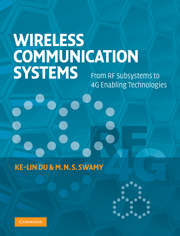Book contents
- Frontmatter
- Contents
- Preface
- Abbreviations
- 1 Introduction
- 2 An overview of wireless communications
- 3 Channel and propagation
- 4 Cellular and multiple-user systems
- 5 Diversity
- 6 Channel estimation and equalization
- 7 Modulation and detection
- 8 Spread spectrum communications
- 9 Orthogonal frequency division multiplexing
- 10 Antennas
- 11 RF and microwave subsystems
- 12 A/D and D/A conversions
- 13 Signals and signal processing
- 14 Fundamentals of information theory
- 15 Channel coding
- 16 Source coding I: speech and audio coding
- 17 Source coding II: image and video coding
- 18 Multiple antennas: smart antenna systems
- 19 Multiple antennas: MIMO systems
- 20 Ultra wideband communications
- 21 Cognitive radios
- 22 Wireless ad hoc and sensor networks
- Appendix A The Q-function
- Appendix B Wirtinger calculus
- Index
19 - Multiple antennas: MIMO systems
Published online by Cambridge University Press: 05 June 2012
- Frontmatter
- Contents
- Preface
- Abbreviations
- 1 Introduction
- 2 An overview of wireless communications
- 3 Channel and propagation
- 4 Cellular and multiple-user systems
- 5 Diversity
- 6 Channel estimation and equalization
- 7 Modulation and detection
- 8 Spread spectrum communications
- 9 Orthogonal frequency division multiplexing
- 10 Antennas
- 11 RF and microwave subsystems
- 12 A/D and D/A conversions
- 13 Signals and signal processing
- 14 Fundamentals of information theory
- 15 Channel coding
- 16 Source coding I: speech and audio coding
- 17 Source coding II: image and video coding
- 18 Multiple antennas: smart antenna systems
- 19 Multiple antennas: MIMO systems
- 20 Ultra wideband communications
- 21 Cognitive radios
- 22 Wireless ad hoc and sensor networks
- Appendix A The Q-function
- Appendix B Wirtinger calculus
- Index
Summary
Introduction
MIMO systems are wireless systems with multiple antenna elements at both ends of the link. MIMO systems can be used for beamforming, diversity combining, or spatial multiplexing. The first two applications are the same as for the smart antennas, while spatial multiplexing is the transmission of multiple data streams on multiple antennas in parallel, leading to a substantial increase in capacity. MIMO technology and turbo coding are the two most prominent recent breakthroughs in wireless communications. MIMO technology promises a significant increase in capacity.
MIMO systems have the ability to exploit, rather than combat, multipath propagation. The separability of the MIMO channel relies on the presence of rich multipath, which makes the channel spatially selective. Thus, MIMO effectively exploits multipath. In contrast, some smart antenna systems perform better in the LOS case, and their optimization criteria are based on the DoA/DoD. Although some smart antenna systems generate good results in the non-LOS channel, they mitigate multipath rather than exploit it.
The maximum spatial diversity obtained for a non-frequency-selective fading MIMO channel is proportional to the product of the numbers of receive and transmit antennas. In the uncorrelated Rayleigh fading channel, the MIMO channel capacity/throughout limit grows linearly with the number of transmit or receive antennas, whichever is smaller − i.e., min (Nt, Nr). According to the analysis and simulation performed in, MIMO can provide a spectral efficiency as high as 20–40 bits/s/Hz.
- Type
- Chapter
- Information
- Wireless Communication SystemsFrom RF Subsystems to 4G Enabling Technologies, pp. 788 - 869Publisher: Cambridge University PressPrint publication year: 2010

